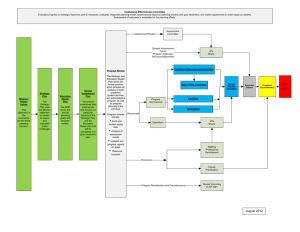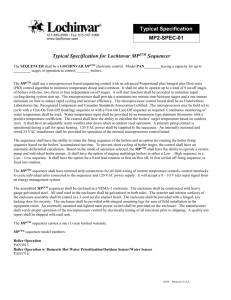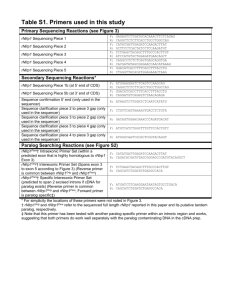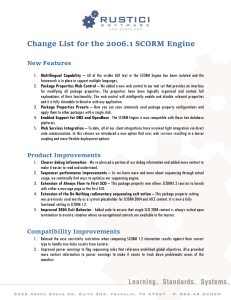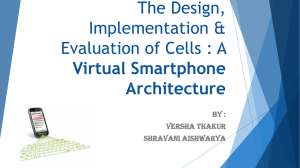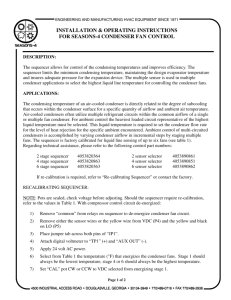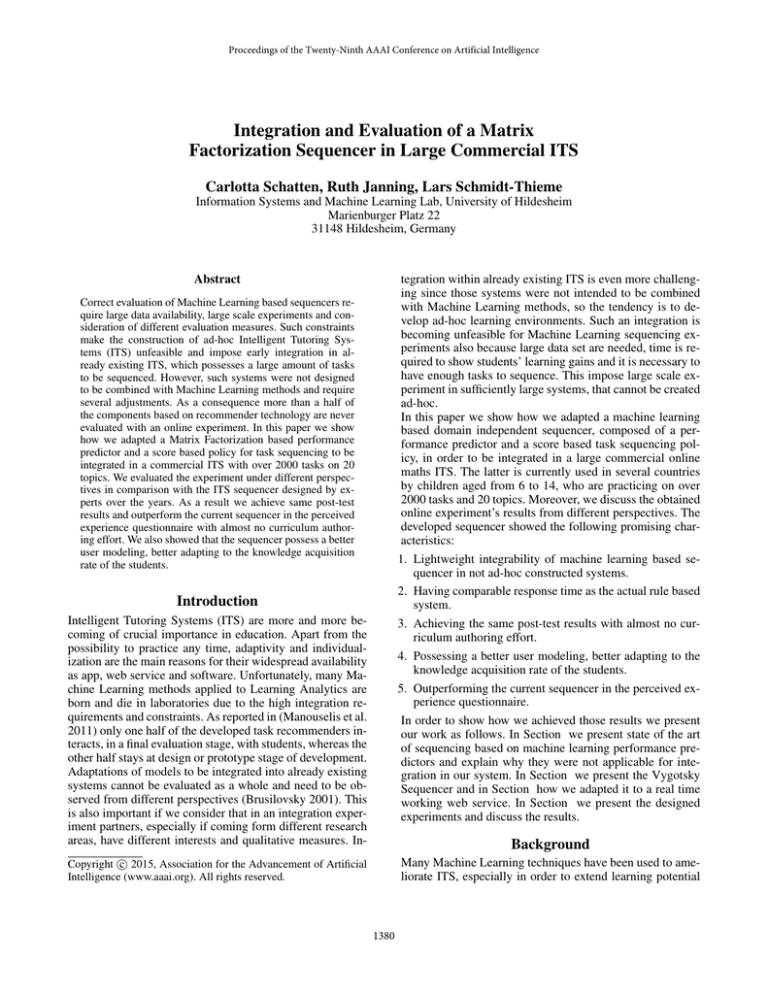
Proceedings of the Twenty-Ninth AAAI Conference on Artificial Intelligence
Integration and Evaluation of a Matrix
Factorization Sequencer in Large Commercial ITS
Carlotta Schatten, Ruth Janning, Lars Schmidt-Thieme
Information Systems and Machine Learning Lab, University of Hildesheim
Marienburger Platz 22
31148 Hildesheim, Germany
Abstract
tegration within already existing ITS is even more challenging since those systems were not intended to be combined
with Machine Learning methods, so the tendency is to develop ad-hoc learning environments. Such an integration is
becoming unfeasible for Machine Learning sequencing experiments also because large data set are needed, time is required to show students’ learning gains and it is necessary to
have enough tasks to sequence. This impose large scale experiment in sufficiently large systems, that cannot be created
ad-hoc.
In this paper we show how we adapted a machine learning
based domain independent sequencer, composed of a performance predictor and a score based task sequencing policy, in order to be integrated in a large commercial online
maths ITS. The latter is currently used in several countries
by children aged from 6 to 14, who are practicing on over
2000 tasks and 20 topics. Moreover, we discuss the obtained
online experiment’s results from different perspectives. The
developed sequencer showed the following promising characteristics:
1. Lightweight integrability of machine learning based sequencer in not ad-hoc constructed systems.
2. Having comparable response time as the actual rule based
system.
3. Achieving the same post-test results with almost no curriculum authoring effort.
4. Possessing a better user modeling, better adapting to the
knowledge acquisition rate of the students.
5. Outperforming the current sequencer in the perceived experience questionnaire.
In order to show how we achieved those results we present
our work as follows. In Section we present state of the art
of sequencing based on machine learning performance predictors and explain why they were not applicable for integration in our system. In Section we present the Vygotsky
Sequencer and in Section how we adapted it to a real time
working web service. In Section we present the designed
experiments and discuss the results.
Correct evaluation of Machine Learning based sequencers require large data availability, large scale experiments and consideration of different evaluation measures. Such constraints
make the construction of ad-hoc Intelligent Tutoring Systems (ITS) unfeasible and impose early integration in already existing ITS, which possesses a large amount of tasks
to be sequenced. However, such systems were not designed
to be combined with Machine Learning methods and require
several adjustments. As a consequence more than a half of
the components based on recommender technology are never
evaluated with an online experiment. In this paper we show
how we adapted a Matrix Factorization based performance
predictor and a score based policy for task sequencing to be
integrated in a commercial ITS with over 2000 tasks on 20
topics. We evaluated the experiment under different perspectives in comparison with the ITS sequencer designed by experts over the years. As a result we achieve same post-test
results and outperform the current sequencer in the perceived
experience questionnaire with almost no curriculum authoring effort. We also showed that the sequencer possess a better
user modeling, better adapting to the knowledge acquisition
rate of the students.
Introduction
Intelligent Tutoring Systems (ITS) are more and more becoming of crucial importance in education. Apart from the
possibility to practice any time, adaptivity and individualization are the main reasons for their widespread availability
as app, web service and software. Unfortunately, many Machine Learning methods applied to Learning Analytics are
born and die in laboratories due to the high integration requirements and constraints. As reported in (Manouselis et al.
2011) only one half of the developed task recommenders interacts, in a final evaluation stage, with students, whereas the
other half stays at design or prototype stage of development.
Adaptations of models to be integrated into already existing
systems cannot be evaluated as a whole and need to be observed from different perspectives (Brusilovsky 2001). This
is also important if we consider that in an integration experiment partners, especially if coming form different research
areas, have different interests and qualitative measures. In-
Background
Many Machine Learning techniques have been used to ameliorate ITS, especially in order to extend learning potential
c 2015, Association for the Advancement of Artificial
Copyright Intelligence (www.aaai.org). All rights reserved.
1380
2012), but all experiments were done with simulated students’ interactions. (Manouselis et al. 2011) reports that recommender techniques for ITS are rarely integrated in larger
systems. This happens because it is a common approach to
build entire ITS to test sequencers making large scale experiments almost not affordable for universities (Schatten et
al. 2014b). As discussed in (Schatten et al. 2014a; Janning,
Schatten, and Schmidt-Thieme 2014; Janning, Schatten, and
Lars 2014) the integration of Machine Learning components
for applications in ITS, also if domain independent such as
(Schatten and Schmidt-Thieme 2014), needs some tailoring.
The first paper considers some preliminary analysis to evaluate feasibility of integration, whereas the second and the
third suggest how to further personalize the sequencing parameter of (Schatten and Schmidt-Thieme 2014) with features coming from speech based emotion recognition.
for students and reduce engineering efforts for designing the
ITS. The most used technology for sequencing is Reinforcement Learning (RL), which computes the best sequence
trying to maximize a previously defined reward function.
Both model–free and model–based (Malpani, Ravindran,
and Murthy 2011; Beck, Woolf, and Beal 2000) RL were
tested for content sequencing. Unfortunately, the model–
based RL necessitates of special kind of data sets called
exploratory corpus. Available data sets are log files of ITS
which have a fixed sequencing policy that teachers designed
to grant learning. They explore a small part of the state–
action space and yield to biased or limited information. For
instance, since a novice student will never see an exercise
of advanced level, it is impossible to retrieve the probability of a novice student solving those tasks correctly. Without these probabilities the RL model cannot be built (Chi et
al. 2011), moreover it excluded the already collected corpus
(more than five years of data) we were planning to use for
the experiment. Model–free RL assumes a high availability
of students on which one can perform an on-line training.
The model does not require an exploratory corpus but needs
to be built while the users are playing with the designed system. Given the high cost of an experiment with humans, this
technique is not advised in case of costly data collection (Chi
et al. 2011).
The integrated and evaluated task sequencer is based on student performance predictions. An example of state of the
art method is Bayesian Knowledge Tracing (BKT) and its
extensions. The algorithm is built on a given prior knowledge of the students and a data set of binary students’ performances. It is assumed that there is a hidden state representing the knowledge of a student and an observed state
given by the recorded performances. The model learned is
composed by slip, guess, learning and not learning probability, which are then used to compute the predicted performances (Corbett and Anderson 1994). In the BKT extensions also difficulty, multiple skill levels and personalization are taken into account separately (Wang and Heffernan 2012; Pardos and Heffernan 2010; 2011; D Baker,
Corbett, and Aleven 2008). BKT researchers have discussed
the problem of sequencing both in single and in multiple
skill environment in (Koedinger et al. 2011). Another domain dependent algorithm used for performance prediction
is the Performance Factors Analysis (PFM). In the latter the
probability of learning is computed using the previous number of failures and successes, i.e. the score representation is
binary as in BKT (Pavlik and Koedinger 2009). Moreover,
similarly to BKT, a table connecting contents and skills is
required.
As we do not have access to the necessary skills information for the more than 2000 tasks in the chosen ITS, Matrix Factorization (MF) represents a good alternative to BKT
and PFM. It has many applications like, for instance, dimensionality reduction, clustering and also classification (Cichocki et al. 2009). Its most common use is for Recommender Systems (Koren, Bell, and Volinsky 2009) and recently this concept was extended to performance prediction
and to sequencing problems in ITS (Thai-Nghe et al. 2011;
Schatten and Schmidt-Thieme 2014; Thai-Nghe et al. 2010;
Vygotsky Sequencer
The Vygotsky Policy Sequencer (VPS) is the domain independent sequencer we tested in our experiment. It was presented the first time in (Schatten and Schmidt-Thieme 2014)
and is composed of two components: a performance prediction method and a score based policy. Because of its domain
independence, the authors chose Matrix Factorization (MF)
as score predictor, but other performance predictors returning a continuous value between 0 and 1 could be used. The
matrix Yt ∈ Rns ×nc can be seen as a table of nc total tasks
and ns students used to learn the students’ model, where
for some tasks and students performance measures are given
at time t. MF decomposes the matrix Y in two other ones
Ψ ∈ Rnc ×P and Φ ∈ Rns ×P , so that Yt ≈ Yˆt = ΨΦT .
Ψ and Φ are matrices of latent features. Their elements are
learned with gradient descend from the given performances.
This allows computing the missing elements of Y for each
student i in each task j of the dataset Yt . The optimization
function is represented by:
X
2
2
2
min
(yij − ŷij ) + λ(kΨk + kΦk ),
(1)
ψj ,ϕi
i,j∈Yt
where one wants to minimize the regularized squared error
on the set of known scores optimizing variables ψ and ϕ.
MF prediction is computed as:
ŷij = µ + µcj + µsi +
P
X
ϕip ψjp
(2)
p=0
where µ, µc and µs are respectively the average performance
of all tasks of all students, the learned average performance
of a content, and learned average performance of a student.
The two last mentioned parameters are also learned with the
gradient descend algorithm.
The second component is a policy π that exploits the information of the performance predictor to select the next
task. Given the predicted score for each student on each task,
the VPS wants to sequence tasks in a way that attempts to
keep students in this so-called zone of proximal development (ZPD) (Vygotsky 1978), which, in this context, is associated with tasks that are neither too easy nor too difficult
1381
to accomplish without much help. This concept is formalized by the following formula:
ct∗ = argminc yth − ŷ t (c) ,
(3)
where yth is a threshold score that will challenge the students and keep them in the ZPD. The so-called Vygotsky
Policy (VP) will select at each time step the content ct∗ with
the predicted score ŷ t at time t most similar to yth as described in Alg. 1, where si is the student currently interacting with the system and C is the number of tasks available. In (Schatten and Schmidt-Thieme 2014) evaluation on
Figure 1: Two questions of the commercial ITS
Algorithm 1: Vygotsky Policy based Sequencer
1
2
3
4
5
6
7
8
9
10
Input: C, Y0 π, si , T
Train the MF using Y0 ;
for t = 1 to T do
for All c ∈ C do
Predict ŷ (cj , si ) Eq. 2;
end
Find ct∗ according to Eq. 3;
Show ct∗ to si
Add y si , ct∗ to Yt ;
Retrain the MF solving Eq. 1
end
Table 1: Dataset Statistics
Number of Tasks
Number of Students
Total Student-Task Interactions
Average score obtained
2035
116843
15782070
8.1
Commercial ITS and Dataset study
In order to design the experiment an understanding of the
ITS and its dataset was required. The ITS has 20 topics about
maths for children aged from 6 to 14, who can practice on
over 2000 tasks at school or at home. The ITS possesses
two kinds of tasks: exercises and tests. A test task cannot
be shown if the student did not pass the corresponding exercise. Exercises and tests are composed of a set of questions
that can be evaluated with correct and incorrect; an example can be found in Fig. 1. From these questions we do not
know which ones were answered correctly since the ITS aggregates the information in a single score. In the exercises
three hints are available and the last one is the bottom-out
one displaying the solution. As a consequence students can
pass exercises although they did not learn, but cannot proceed because they fail the tests. The score, as in (Schatten
and Schmidt-Thieme 2014), is represented in a continuous
interval which goes from 0 to 10. The topics and new skills
to be acquired are introduced following the curriculum of
the country. This also defines the Math Age which represents both the student’s skills level on a topic and task’s difficulty level. Tasks are assigned to topics and students have
a Math Age per topic. Considering a specific topic, a task of
Math Age 10 means that the difficulty should be solved by
students of that age. It means also that a student with Math
Age of 10 in a topic knows more than a student of Math Age
9. The commercial system possesses a rule–based adaptive
sequencer that was designed and refined by pedagogical experts over the year that we call state of the art (SotA) sequencer. The Math Age is the indicator the SotA sequencer
uses to monitor the progress within the curriculum and select
the next tasks. A student can see tasks of the next difficulty
level only if the ones of the previous level are completed.
We analyzed the dataset collecting the information summarized in Tab.1. In order to avoid sparseness, which strongly
affects MF, each line is generally abstracted to Knowledge
groups of simulated students in comparison to several sequences showed the advantages of such a system. There is
no authoring effort for sequencing required, since the system is flexible enough to adapt to ITS with different number of tasks to practice per difficulty level. Most advantages
are gained with large or small task availability per difficulty
level. Given a curriculum that possesses the correct number
of tasks to practice with for each difficulty level, the performances between a sequencer that selects tasks in order of
difficulty and the VPS are comparable. On the contrary, if
there are more tasks of the same difficulty level, VPS is able
to skip the unnecessary ones. However, an evaluation with
real students is required to confirm the results obtained in a
simulated environment. The most interesting scenario for an
evaluation would need an ITS with many tasks, where the
sequencer could reduce the burden of pedagogical experts.
Given the interdisciplinary knowledge required for creating
such an ITS from scratch the experiment, without integration with an already existing system, would not have been
affordable.
Integration in a commercial ITS
In order to integrate the system into a commercial ITS two
steps need to be performed. The first one consists of an offline study and evaluation of the commercial system and its
dataset, where the quality of the dataset is discussed. After a
dataset preprocessing it is possible to create a first model and
select the parameters of the VP. In the second step the system
is taken to real time performances in order to be integrated
in the commercial ITS. This involved the implementation of
an online update for the MF algorithm and of a lightweight
API.
1382
Thieme 2014) a sensitiveness analysis of the VP to yth
was done with simulated students. The same approach in a
real scenario was considered detrimental for children, consequently the threshold score was selected according to the
authors experience with the system and according to following considerations. In (Schatten and Schmidt-Thieme 2014)
was discussed that, in order to keep the student in the ZPD,
the selected score should be good, in order to be able to assume that the student was learning something from the task,
but also not excellent, to avoid unnecessary repetitions on already known concepts. (Schatten et al. 2014a) suggested to
select the threshold in the middle of the passing range, i.e.
given a passing score of 5.5/10 one should select as threshold score 8/10. Our decision was made also on further considerations. Given the characteristics of the MF we assumed
that the model was going to underestimate the performances
of the student, so 8 as threshold score would have been too
high. Moreover, experts, that were analyzing the tasks, suggested that the path through the curriculum could be ameliorated by removing unnecessary repetitions rather than increasing practice. Consequently, we decided to choose a
threshold score yth = 6.5, i.e. the lowest possible in the
passing range keeping a safe guard in case of overestimation
by the model.
A further policy adjustment was required since in exercise
modality bottom out hints are available. We decided to consider only test predictions to evaluate students’ability. As a
consequence only tests are selected with the VP. Whether
or not the correspondent exercise should be shown is decided considering the performance prediction, if the score
predicted is higher than 9.5/10 the exercise is skipped.
Component (KC) level, i.e. the algorithm predicts if the
student is going to answer correctly modeling his knowledge on a KC. Since we did not have this information, we
preprocessed the dataset at task level predicting the future
score for each task. In order to select the best performing model we followed the standard approach in the field
to divide the dataset temporally in two thirds for training
and one third for testing, evaluating the performances with
the Root Mean Square Error (RMSE). We considered the
last 3 years of data, excluding the oldest ones, since the
tasks were slightly modified over time. We also removed the
skipped tasks, where the score is automatically assigned to
7.5 out of 10 (7.5/10) by the ITS. Those data were considered noisy since there was no evidence that 7.5/10 could represent the knowledge of the student at that time. With a full
grid search we selected the best hyperparameters’ combination (P = 50,λ = 0.01, learn rate = 0.02, 100 iterations per
training) with whom we obtained an average RMSE of 0.13
over 5 experiments.
Online update integration
It is well known to those working with recommender technology that MF does not deal with time, i.e. all the training performances are considered equally. As a consequence
if the student is repeating a task his mark is computed as
the weighted sum of the previous performances. Two past
data on the same task are considered equally. Since the
students’features change after each interaction in (Schatten
and Schmidt-Thieme 2014) the model was retrained each
time. Given the data amount this was not feasible while students were interacting with the system. In order to keep the
model up to date, we implemented the online update proposed in (Rendle and Schmidt-Thieme 2008) that was previously tested for active learning problems in recommender
systems. The method is an approximation of the retrain, the
paper reports how the performances of the update deteriorates over time in comparison to the entire retrain. Considering Alg. 1, we solved again the minimization problem of Eq.
1 optimizing ϕ with gradient descend algorithm. We noticed
that after approximately 20 interactions the model’s update
was not updating features as expected. This is coherent with
the errors behavior reported in (Rendle and Schmidt-Thieme
2008). As a consequence, each night we retrained the model,
assuming students would see approximately 10 tasks per
day. Given the large data availability we had no cold–start
problem, which is experienced in MF when not enough data
on tasks or on students are available. The task cold–start
problem is not common to the movie rating applications
since there the data availability is higher, but could be experienced in ITS use. For this reason it was crucial to have
a partner with large data availability both on tasks and on
students. We were able to select 100 students coming from
the same school and that had already experience with the
system, so that also the student cold–start problem could be
avoided.
Technical Integration
As proposed in (Schatten et al. 2014b) we integrated the
VPS within the ITS with a single method API. The minimal
integration effort, visible in Alg. 2, was crucial to convince
the commercial partner to invest time and effort integrating a
sequencer still not fully evaluated. The parameters passed by
the method Get N ext T ask have the following function.
The student ID, the task ID and the relative score obtained
are required in order to maintain the VPS database up to
date. The method Get N ext T ask was called after the use
of the old sequencer by the ITS but before the sequencing
decision is applied as shown in Alg. 2. N extT askID contained the task suggestion of the state of the art sequencer,
so that the VPS was able to manage the A/B test, deciding which students were practicing with which sequencer.
Moreover, to be robust to connection problems we used a
timestamp indicating when the data was recorded in order
to avoid inserting duplicates in the DB. Moreover, a timeout
variable was used at ITS side for connection problems.
This single method was exposed as Web Service. The resulting architecture of the system can be seen in Fig. 2, where
the three blocks, student interfaces, ITS platform and VPS,
are connected through the web.
Experiment Session
Vygotsky Policy Integration
The policy integration consisted first of all in selecting the
threshold score yth (see Eq. 3). In (Schatten and Schmidt-
The purposes of the trial with the students were several.
Firstly, we wanted to show that it is possible to sequence
1383
Avg Math Age Improvement
Avg Start Math Age
Avg End Math Age
Avg Tasks Score
Inter Topic StD
MF Error
VPS
0.06±0.038
8.41±1.42
9.72±1.92
6.82±0.901
0.64 ±0.30
0.317±0.10
SotA
0.03±0.0354
8.26±1.94
8.84±2.02
7.9±0.992
0.32±0.44
-
Table 2: Trial Data Analysis. Values are indicated with ±
standard deviation
Figure 2: System Architecture
periments in (Schatten and Schmidt-Thieme 2014) an active
range seemed not to be required we preferred to adopt this
risk minimization procedure in order to avoid frustrating excessively the students in case of experiment failure. Experts
considered the range adequate for an ethically correct experiment and large enough for being able to evaluate the ability
of the VPS to construct a reasonable path. For introducing
new topics we adopted the simple policy of showing them
the easiest available task, further tasks on the topic are selected in the active range with the Vygotsky policy.
Algorithm 2: Implementing the Web Service, client side
1
2
3
4
Input: StudentID, PreviousTaskID, PreviousScore,
TimeStamp
NextTask = Get Next Task SotA();
if !timeout then
Get Next Task(StudentID, PreviousTaskID,
PreviousScore, NextTaskID, TimeStamp);
end
Results from Data set Analysis
tasks by just considering students’ score without frustrating
them. Secondly, we wanted to evaluate sequencer performances in comparison with the current sequencer used by
the ITS, which was adapted over the years to the tasks and
countries curricula. In order to answer these questions we
analyzed the following success criteria: learning gains evaluated with trial data analysis, comparison of questionnaire
and post test scores with the SotA sequencer, and finally we
evaluate integration performances. To demonstrate the last
point is known to be problematic since the most used indicator is the learning gain of students. This is generally obtained with a large number of students and over extensive
time. Schools agreed with us to let 98 children interact with
the ITS 45 minutes a week for 4 weeks. Another appointment in the fifth week was granted for a 30 minutes post test
and a five question questionnaire for the perceived experience. Students were able to practice also at home and use
all other related features of the ITS, e.g. spend coins gained
for passing tasks for decorating their virtual room. Of the
98 students that were assigned to the study we randomly assigned them to two groups one was practicing with the SotA
sequencer and one with the VPS. Students did not know to
which system they were assigned. Given the reduced amount
of time we could not let students practice with all 20 topics
in order to be able to monitor any learning gain. We selected
3 topics and one recall topic, i.e. Fractions, Properties of
Numbers, Solving Problems as well as Rapid Recall on additions and subtractions. Moreover, we limited the VPS degree
of freedom by defining an active range for each topic, i.e.
we selected a subset of tasks between which the VPS could
choose in order to limit difficulty jumps. The active range of
each topic is initialized with the Math Age of the most difficult task of a topic a student could solve, this represents the
center of the range. We then allowed only tasks around +/one year Math Age from the center. Each time the student
is able to solve a more difficult task in test mode the center
of the active range is updated. Although from simulated ex-
From the 98 students we filtered those that practiced on less
than 10 tasks and/or did not participate to all tests having
80 students left. From the trial data analysis we could notice that there was no big usage difference. Both groups approximately saw 2000 tasks in a month. In order to have a
learning gain comparison we computed the average Math
Age per student and per topic at the beginning (Avg Start
Math Age) and at the end (Avg End Math Age) of the experiment. We then normalized the difference, i.e. the students’
learning gain, with the number of tasks seen, in order to exclude also amount of practice differences (Avg Math Age
Improvement). As one can see from in Tab. 2 the average
improvement of VPS students per task is double as much as
the SotA ones. This proved that the VPS is able to propose
tasks in a way that students can proceed in the curriculum
also if this is composed by different topics. However, by observing Fig. 3 it is possible to see how the average standard
deviation (Inter Topic StD) between topics’ Math Age (Inter
Topic Standard Deviation) is higher for those who interacted
more with the system. This means that the inter knowledge
standard deviation between topics’ knowledge will increase
until the student finishes the tasks of some topics, i.e. when
the tasks of the mastered topics will be too easy to be in the
ZPD and the VPS will select those of the uncompleted topics. The performance prediction was working correctly. As
one can see in Tab. 2 the average score for VPS students is
6.82, i.e. the threshold score 6.5 plus a slight overestimation,
as expected. The average score of the SotA students is coherent with those of the data used to train the model as one
could see comparing Tab. 2, 1.
Post Test
The trial post-test comprised 15 questions; 5 corresponding
to each of the three topics, excluding the recall. The questions were sourced by experts from the ITS library of tasks
1384
VPS
SotA
Q1
3.76
±1.03
3.59
±1.23
Q2
3.69
±1.22
3.9
±1.12
Q3
3.26
±1.13
3.49
±1.13
Q4
3.56
±0.98
3.51
±1.29
Q5
4
±0.95
3.49
±1.11
Table 4: Questionnaire comparison. 1: strong disagreement,
5: strong agreement. Values are indicated with ± standard
deviation
• Q2: Were the exercises repetitive?
• Q3: Were the exercises easy?
• Q4: Was the ITS helpful?
• Q5: Was the ITS easy to understand?
The students could give a vote between 1 and 5 where 5
meant strong agreement and 1 strong disagreement.
As one can see in Tab.4 in almost all questions the VPS
is slightly better than the SotA sequencer except from Q4
where the outcome is equal. In general the experience was
positive, as one can see from Q1 and Q4. There where no
usability issues related to introduction of the sequencer as
reported from Q5. In Q3 students stated that tasks were between the adequate difficulty and too easy. This is coherent
with the outcome of the post tests since the tasks proposed
were too easy at the beginning. The VPS was better at adapting to the students’ learn rate, so the sequence proposed by
the VPS was perceived by the students to be of a more correct difficulty level. This agrees also with the data analysis
where the average score of the VPS students is lower than
the those of the SotA group. The only negative comment reported was the repetitiveness that could have been perceived
by both groups for several reasons. Firstly because the set
of questions in the tasks cannot be interrupted, secondly because the recall tasks are similar with one another but in the
commercial version are presented interleaved with more topics.
Figure 3: Inter topic standard deviation, i.e. average of the
standard deviation between Topic Math Age for students that
interacted with 10-24, 25-49, 50-99, or 100-150 tasks.
VPS
SotA
Post Test Score
6.68±1.53
6.70±1.79
Average Math Age
9.94±0.60
9.96±0.71
Table 3: Post Test Comparison. Values are indicated with ±
standard deviation
ensuring that the Math Age assigned to the task was consistent with their perceived difficulty of each chosen question,
and that the questions range of difficulty level was broad
and considering each difficulty level. Given the average age
of student this range was from Math Age 7.5 to 11.0. All 15
questions were taken from the test tasks. These originally existed in paper form and were adapted to the online ITS tutor.
Thus, converting the digital questions back to their original
form required no work, and the questions lost no key form
factors (such as digital interactivity) in the conversion process. For each question one point was assigned so that the
sum of points obtained, normalized in a 0 to 10 range, represents the score of the post test. Moreover, taking the tests
from the ITS curriculum, allowed the experts to reassess the
student knowledge in order to compute the actual Math Age.
As expected due to the short time period of the trial, no difference in average score and Math Age can be seen between
the two groups (Tab. 3). This means that the sequencer does
not damage learning. This result could appear at first glance
in contrast with the average Math Age improvement, however the final average Math age reported in Tab. 2 of VPS
students, i.e. the most difficult task students could solve, is
more similar to those evaluated by experts in the post test.
This means the VPS system was able to better model the
current knowledge of the student and adapt to it.
Integration
We rented a server with 8 virtual CPUs, 30Gb RAM and two
SSD of 80Gb each. The adapted VPS required 6s worst case
to: identify the student, his appertaining group, update the
model, and select the next task from the subset with the VP.
The last action was not always necessary, if, for instance,
the student had to practice with the correspondent test of an
exercise or if he was of the SotA group and then the suggestion of the ITS needed just to be forwarded. The sequencing
time could be further reduce by indexing the DB, but we
did not require to do so, since response times were already
comparable to those of the current SotA sequencer. The implementation was tested with 30 students practicing at the
same time, but we do not exclude it could work with more.
Conclusions and Future Work
Questionnaire
In this paper we showed how we integrated the Vygotsky sequencer in a commercial ITS and we analyzed its potential
from different perspectives. Although there was a high standard deviation due to the small sample, results are promis-
In order to evaluate the perceived experience of the students
following questions were posed to them.
• Q1: Was the ITS fun?
1385
Manouselis, N.; Drachsler, H.; Vuorikari, R.; Hummel, H.;
and Koper, R. 2011. Recommender systems in technology enhanced learning. In Recommender systems handbook.
Springer. 387–415.
Pardos, Z. A., and Heffernan, N. T. 2010. Modeling individualization in a bayesian networks implementation of knowledge tracing. In UMAP. Springer.
Pardos, Z. A., and Heffernan, N. T. 2011. Kt-idem: introducing item difficulty to the knowledge tracing model. In
UMAP. Springer. 243–254.
Pavlik, P., C. H., and Koedinger, K. 2009. Performance
factors analysis-a new alternative to knowledge tracing. In
AIED.
Rendle, S., and Schmidt-Thieme, L. 2008. Online-updating
regularized kernel matrix factorization models for largescale recommender systems. In Proceedings of the 2008
ACM conference on Recommender systems, 251–258. ACM.
Schatten, C., and Schmidt-Thieme, L. 2014. Adaptive content sequencing without domain information. In CSEDU.
Schatten, C.; Mavrikis, M.; Janning, R.; and SchmidtThieme, L. 2014a. Matrix factorization feasibility for sequencing and adaptive support in its. In EDM.
Schatten, C.; Wistuba, M.; Schmidt-Thieme, L.; and
Gutirrez-Santos, S. 2014b. Minimal invasive integration of
learning analytics services in its. In ICALT.
Thai-Nghe, N.; Drumond, L.; Krohn-Grimberghe, A.; and
Schmidt-Thieme, L. 2010. Recommender system for predicting student performance. Procedia Computer Science
1(2):2811–2819.
Thai-Nghe, N.; Drumond, L.; Horvath, T.; KrohnGrimberghe, A.; Nanopoulos, A.; and Schmidt-Thieme,
L. 2011. Factorization techniques for predicting student
performance.
Educational Recommender Systems and
Technologies: Practices and Challenges. IGI Global.
Thai-Nghe, N.; Drumond, L.; Horvath, T.; and SchmidtThieme, L. 2012. Using factorization machines for student
modeling. In UMAP Workshops.
Vygotsky, L. L. S. 1978. Mind in society: The development
of higher psychological processes. HUP.
Wang, Y., and Heffernan, N. T. 2012. The student skill
model. In ITS2012.
ing, showing how the Vygotsky sequencer was able to better
model the students’knowledge. This result is coherent with
the results of the questionnaire and the post test. The latter
tests also show that the VPS is not damaging learning and
that children had an experience comparable with the SotA
sequencer, a sequencer that was modeled by experts over the
years. Our future planned work is to test with more students
and for a longer period of time so that we get the chance to
monitor learning gains also in the post test. Moreover, we
will develop a policy for topic sequencing.
Acknowledgments
The research leading to the results reported here has received funding from the European Union Seventh Framework Programme (FP7/20072013) under grant agreement
No. 318051 iTalk2Learn project (www.italk2learn.eu). Furthermore, we thank our project partners the London Institute
of Education and Whizz, in particular Junaid Mubeen, who
organized the trial with the students and helped preparing the
post assessment and the perceived experience questionnaire.
References
Beck, J.; Woolf, B. P.; and Beal, C. R. 2000. Advisor: A machine learning architecture for intelligent tutor construction.
AAAI/IAAI 2000:552–557.
Brusilovsky, P. 2001. Adaptive hypermedia. User modeling
and user-adapted interaction 11(1-2).
Chi, M.; VanLehn, K.; Litman, D.; and Jordan, P. 2011. Empirically evaluating the application of reinforcement learning to the induction of effective and adaptive pedagogical
strategies. UMAI.
Cichocki, A.; Zdunek, R.; Phan, A. H.; and Amari, S.-i.
2009. Nonnegative matrix and tensor factorizations: applications to exploratory multi-way data analysis and blind
source separation. Wiley. com.
Corbett, A., and Anderson, J. 1994. Knowledge tracing:
Modeling the acquisition of procedural knowledge. UMAI.
D Baker, R. S.; Corbett, A. T.; and Aleven, V. 2008. More
accurate student modeling through contextual estimation of
slip and guess probabilities in bayesian knowledge tracing.
In ITS, 406–415. Springer.
Janning, R.; Schatten, C.; and Lars, S.-T. 2014. Feature
analysis for affect recognition supporting task sequencing.
In ECTEL.
Janning, R.; Schatten, C.; and Schmidt-Thieme, L. 2014.
Multimodal affect recognition for adaptive intelligent tutoring systems. In FFMI EDM.
Koedinger, K.; Pavlik, P.; Stamper, J.; Nixon, T.; and Ritter,
S. 2011. Avoiding problem selection thrashing with conjunctive knowledge tracing. In EDM.
Koren, Y.; Bell, R.; and Volinsky, C. 2009. Matrix factorization techniques for recommender systems. Computer
42(8):30–37.
Malpani, A.; Ravindran, B.; and Murthy, H. 2011. Personalized intelligent tutoring system using reinforcement learning. In FLAIRS.
1386


